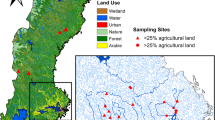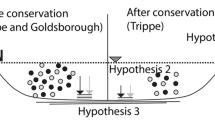Abstract
The Minnesota River Basin (MRB), situated in the prairie pothole region of the Upper Midwest, contributes excessive sediment and nutrient loads to the Upper Mississippi River. Over 330 stream channels in the MRB are listed as impaired by the Minnesota Pollution Control Agency, with turbidity levels exceeding water quality standards in much of the basin. Addressing turbidity impairment requires an understanding of pollutant sources that drive turbidity, which was the focus of this study. Suspended volatile solids (SVS), total suspended solids (TSS), and turbidity were measured over two sampling seasons at ten monitoring stations in Elm Creek, a turbidity impaired tributary in the MRB. Turbidity levels exceeded the Minnesota standard of 25 nephelometric units in 73% of Elm Creek samples. Turbidity and TSS were correlated (r 2 = 0.76), yet they varied with discharge and season. High levels of turbidity occurred during periods of high stream flow (May–June) because of excessive suspended inorganic sediment from watershed runoff, stream bank, and channel contributions. Both turbidity and TSS increased exponentially downstream with increasing stream power, bank height, and bluff erosion. However, organic matter discharged from wetlands and eutrophic lakes elevated SVS levels and stream turbidity in late summer when flows were low. SVS concentrations reached maxima at lake outlets (50 mg/l) in August. Relying on turbidity measurements alone fails to identify the cause of water quality impairment whether from suspended inorganic sediment or organic matter. Therefore, developing mitigation measures requires monitoring of both TSS and SVS from upstream to downstream reaches.
Similar content being viewed by others
References
Allan, J. D. (1995). Stream ecology: Structure and function of running waters. London: Chapman and Hall.
Almendinger, J. E. (1999). A method to prioritize and monitor wetland restoration for water-quality improvement. Wetlands Ecology and Management, 6, 241–251. doi:10.1023/A:1008439031165.
American Rivers Council (1997). North America’s most endangered and threatened rivers of 1997. Washington, DC: American Rivers Council.
Bauer, J. W. (1998). Streambank erosion and slumping along the Blue Earth River. Master’s of Science Thesis. St. Paul, Minnesota: University of Minnesota–Twin Cities.
Campbell, E. (2008). Development of total suspended solids (TSS) surrogates for turbidity in the Minnesota River Basin. Draft report. St. Paul, Minnesota: Minnesota Pollution Control Agency.
Carpenter, S. R., Caraco, N. F., Correll, D. L., Howarth, R. W., Sharpley, A. N., & Smith, V. H. (1998). Nonpoint pollution of surface waters with phosphorus and nitrogen. Ecological Applications, 8(3), 559–568. doi:10.1890/1051-0761(1998)008[0559:NPOSWW]2.0.CO;2.
Chapman, D. (Ed.) (1996). Water quality assessments (2nd ed.). London: Chapman and Hall (on behalf of United Nations Educational, Scientific, and Cultural Organization. E & FN SPON).
Dalzell, B. J., Gouda, P. H., & Mulla, D. J. (2004). Modeling sediment and phosphorus losses in an agricultural watershed to meet TMDLs. Journal of the American Water Resources Association, 2, 533–543. doi:10.1111/j.1752-1688.2004.tb01048.x.
Doyle, M. W., Stanley, E. H., Strayer, D. L., Jacobson, R. B., & Schmidt, J. C. (2005). Effective discharge analysis of ecological processes in streams. Water Resources Research, 41(W11411), 16 pp.
Eaton, A. D., Clesceri, L. S., & Greenberg, A. E. (1995). Standard methods for the examination of water and wastewater (19th ed.). Washington, DC: American Public Health Association.
Ganske, L. W. (2004). Streamflow, total suspended solids, and turbidity characteristics for selected streams of the lower Mississippi River Basin in Minnesota 1993–2002. Draft report. St. Paul, MN: Minnesota Pollution Control Agency.
Goolsby, D. A. (2000). Mississippi Basin nitrogen flux believed to cause Gulf hypoxia: EOS. American Geophysical Union. Transactions, 81(29), 321–327.
Heiskary, S., Wilson, C., & Larsen, D. (1987). Analysis of regional patterns in lake water quality: Using ecoregions for lake management in Minnesota. Lake and Reservoir Management, 3(1), 337–344.
Henley, W. F., Patterson, M. A., Neves, R. J., & Lemly, A. D. (2000). Effects of sedimentation and turbidity on lotic food webs: A concise review for natural resource managers. Reviews in Fisheries Science, 8(2), 125–139. doi:10.1080/10641260091129198.
Johnson, G., Gervino, N., Gunderson, L., Hotka, L., MacGregor, M., Vavricka, M., et al. (2007). Turbidity TMDL protocols and submittal requirements. St. Paul, MN: Minnesota Pollution Control Agency.
Kuehner, K. J. (2004). An historical perspective of hydrologic changes in Seven Mile Creek watershed. In J. L. D’Ambrosio (Ed.), Proceedings of the American Society of Agricultural Engineers (ASAE) conference. St. Joseph, Michigan, USA: ASAE.
Leach, J., & Magner, J. A. (1992). Wetland drainage impacts within the Minnesota river basin. Currents, III(2), 3–10.
Lenhart, C. F. (2008). The influence of watershed hydrology and stream geomorphology on turbidity, sediment and nutrients in tributaries of the Blue Earth River, Minnesota, USA. PhD Thesis. St. Paul, Minnesota: University of Minnesota–Twin Cities.
Leopold, L., Wolman, M. G., & Miller, J. P. (1964). Fluvial processes in geomorphology. New York: Dover.
Magner, J. A., & Brooks, K. N. (2008). Integrating sentinel watershed-systems into the monitoring and assessment of Minnesota’s (USA) water quality. Environmental Monitoring and Assessment, 138, 149–158. doi:10.1007/s10661-007-9752-9.
Magner, J. A., Payne, G. A., & Steffen, L. J. (2004). Drainage effects on stream nitrate-N and hydrology in south-central Minnesota (USA). Environmental Monitoring and Assessment, 91, 183–198. doi:10.1023/B:EMAS.0000009235.50413.42.
Miller, R. C. (1999). Hydrologic effects of wetland drainage and land use change in a tributary watershed of the Minnesota River Basin: A modeling approach. Master’s of Science Thesis. St. Paul, Minnesota: University of Minnesota–Twin Cities.
Minnesota Pollution Control Agency (MPCA) (1994). Minnesota River Assessment Project (MRAP). St. Paul, MN: MPCA.
Minnesota Pollution Control Agency (MPCA) (2008). Minnesota’s impaired waters and total maximum daily loads. http://www.pca.state.mn.us/water/tmdl/index.html.
Murphy, M. (2001). Primary productivity. In R. J. Naiman, & R. E. Bilby (Eds.), River ecology and management: Lessons from the pacific coastal ecoregion. New York: Springer.
Newcombe, C. P., & Jensen, J. (1996). Channel suspended sediment and fisheries: A synthesis for quantitative assessment of risk and impact. North American Journal of Fisheries Management, 16, 693–727. doi:10.1577/1548-8675(1996)016<0693:CSSAFA>2.3.CO;2.
Ojakangas, R. W., & Matsch, C. L. (2004). Minnesota’s geology, 6th printing. St. Paul, MN: University of Minnesota Press.
Packman, J. J., Comings, K. J., & Booth, D. B. (1999). Using turbidity to determine total suspended solids in urbanizing streams in the Puget Lowlands. In Confronting uncertainty: Managing change in water resources and the environment, Canadian water resources association annual meeting (pp. 158–165), Vancouver, BC., 27–29 October.
Quade, H. (2000). Blue Earth River major watershed diagnostic report. Blue Earth River Basin Implementation Framework. South Central Minnesota County, Comprehensive Water Planning Project. Mankato, MN: Joint Powers Board and Water Resources Center, Minnesota State University.
Randall, G. W., Huggins, D. R., Russelle, M. P., Fuchs, D. J., Nelson, W. W., & Anderson, J. L. (1997). Nitrate losses through subsurface tile drainage in Conservation Reserve Program, alfalfa, and row crop systems. Journal of Environmental Quality, 26, 1240–1247.
Sekely, A. (2001). Stream bank slumping and its contribution to the phosphorous and suspended sediment loads of the Blue Earth River. Master’s of Science Thesis. St. Paul, Minnesota: University of Minnesota–Twin Cities.
Simon, A., Dickerson, W., & Heins, A. (2004). Suspended-sediment transport rates at the 1.5 year recurrence interval for ecoregions of the United States: Transport conditions at the bankfull and effective discharge? Geomorphology, 58, 243–262. doi:10.1016/j.geomorph.2003.07.003.
Simon, A., & Rinaldi, M. (2000). Channel instability in the loess area of the Midwestern United States. Journal of the American Water Resources Association, 36(1), 133–150. doi:10.1111/j.1752-1688.2000.tb04255.x.
Thorp, J. H., Thomas, M. C., & Delong, M. D. (2006). The riverine ecosystem synthesis: Biocomplexity in river networks across space and time. River Research and Applications, 22, 123–147. doi:10.1002/rra.901.
Waters, T. F. (1995). Sediment in streams: Sources, biological effects and control. Bethesda, MD: American Fisheries Society.
Winter, T. (1989). Hydrologic studies of wetlands in the northern prairie. In A. van der Valk (Ed.), Northern Prairie wetlands. Ames, Iowa: Iowa State University Press.
Zimmerman, J., Westra, J., & Vondracek, B. (2003). Agricultural land use effects on sediment loading and fish assemblages in two Minnesota (USA) watersheds. Environmental Management, 32(1), 93–105. doi:10.1007/s00267-003-2989-3.
Author information
Authors and Affiliations
Corresponding author
Rights and permissions
About this article
Cite this article
Lenhart, C.F., Brooks, K.N., Heneley, D. et al. Spatial and temporal variation in suspended sediment, organic matter, and turbidity in a Minnesota prairie river: implications for TMDLs. Environ Monit Assess 165, 435–447 (2010). https://doi.org/10.1007/s10661-009-0957-y
Received:
Accepted:
Published:
Issue Date:
DOI: https://doi.org/10.1007/s10661-009-0957-y




